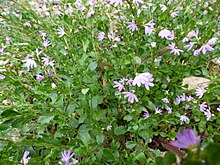Scaevola albida
| White fan-flower | |
|---|---|

| |
| Scaevola albida growing in the ANBG | |

| |
| Appin, NSW | |
| Scientific classification | |
| Kingdom: | Plantae |
| Clade: | Tracheophytes |
| Clade: | Angiosperms |
| Clade: | Eudicots |
| Clade: | Asterids |
| Order: | Asterales |
| Family: | Goodeniaceae |
| Genus: | Scaevola |
| Species: | S. albida
|
| Binomial name | |
| Scaevola albida | |

| |
| Occurrence data from Australasian Virtual Herbarium | |
| Synonyms | |
|
Goodenia albida Sm. | |
Scaevola albida, known by the common name of white fan-flower, is a prostrate shrub found in Australia, growing "from south-eastern Queensland through eastern New South Wales and coastal areas of Victoria and Tasmania in a range of habitats".[2] Unlike most other species of Scaevola which grow into a bush, Scaevola albida is a ground cover, forming a mat on the ground around 30-40 centimetres across. Its leaves are bright green, semi-succulent and slightly hairy. They are of an elliptical shape with wavy edges.
In spring or early summer, the plant bursts into a striking mass of small flowers, which range in colour from snow white, through to pale blue or lilac. Each flower has five petals, which form together in clusters of around four or five flowers. In summer, these flowers turn to small papery, urn-like fruits, containing several flat, disc-like seeds.[3] Scaevola albida germinates readily from fresh seed and also strikes easily from cuttings.
References[]
- ^ "Scaevola albida". Australian Plant Name Index (APNI), IBIS database. Centre for Plant Biodiversity Research, Australian Government, Canberra. Retrieved 27 March 2011.
- ^ "Scaevola albida". www.rbgsyd.nsw.gov.au. Retrieved 7 January 2015.
- ^ "The Native Plants of Adelaide". Department for Environment and Heritage. Retrieved 21 March 2011.
- Scaevola (plant)
- Flora of New South Wales
- Flora of Queensland
- Flora of South Australia
- Flora of Tasmania
- Flora of Victoria (Australia)